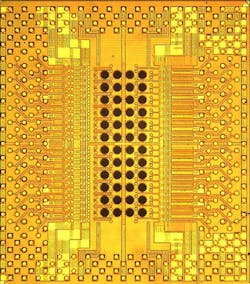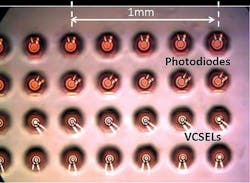"Holey Optochip" parallel optical transceiver from IBM transfers data at 1 Tbps
Los Angeles, CA--Announced at last week's Optical Fiber Conference/National Fiber Optic Engineers Conference (OFC/NFOEC; www.ofcnfoec.org) conference, IBM (NYSE: IBM) announced their "Holey Optochip"—a parallel optical transceiver that they say is the first to transfer one trillion bits—one terabit—of information per second (1 Tbps). The fabrication of tiny holes to improve optoelectronic performance is a growing trend, creating such capabilities as on/off indicators in the Apple iPhone and improving LED performance by creating tiny heatsinks, as reported in Laser Focus World's 2012 Laser Market Review & Forecast.
Parallel optics is a fiber-optic technology primarily targeted for high-data, short-reach multimode fiber systems that are typically less than 150 m. Parallel optics differs from traditional duplex fiber optic serial communication in that data is simultaneously transmitted and received over multiple optical fibers.
A single 90 nm IBM CMOS transceiver IC with 24 receiver and 24 transmitter circuits becomes a Holey Optochip with the fabrication of forty-eight through-silicon holes, or "optical vias"—one for each transmitter and receiver channel. Simple post-processing on completed CMOS wafers with all devices and standard wiring levels results in an entire wafer populated with Holey Optochips. The transceiver chip measures only 5.2 mm x 5.8 mm. Twenty-four channel, industry-standard 850-nm VCSEL (vertical cavity surface-emitting laser) and photodiode arrays are directly flip-chip soldered to the Optochip. The Holey Optochips are designed for direct coupling to a standard 48-channel multimode fiber array through an efficient microlens optical system that can be assembled with conventional high-volume packaging tools.
The raw speed of one transceiver is equivalent to the bandwidth consumed by 100,000 users at today's typical 10 Mbps high-speed internet access. At 1 Tbps, IBM's latest advance in optical chip technology provides unprecedented amounts of bandwidth that could one day ship loads of data such as posts to social media sites, digital pictures and videos posted online, sensors used to gather climate information, and transaction records of online purchases.
"Reaching the one trillion bit per second mark with the Holey Optochip marks IBM's latest milestone to develop chip-scale transceivers that can handle the volume of traffic in the era of big data," said IBM Researcher Clint Schow, part of the team that built the prototype. "We have been actively pursuing higher levels of integration, power efficiency and performance for all the optical components through packaging and circuit innovations. We aim to improve on the technology for commercialization in the next decade with the collaboration of manufacturing partners."
Consistent with green computing initiatives, the Holey Optochip achieves record speed at a power efficiency (the amount of power required to transmit a bit of information) that is among the best ever reported. The transceiver consumes less than 5 W; the power consumed by a 100W light bulb could power 20 transceivers. This progress in power efficient interconnects is necessary to allow companies who adopt high-performance computing to manage their energy load while performing powerful applications such as analytics, data modeling, and forecasting.
SOURCE: IBM; www-03.ibm.com/press/us/en/pressrelease/37095.wss
About the Author

Gail Overton
Senior Editor (2004-2020)
Gail has more than 30 years of engineering, marketing, product management, and editorial experience in the photonics and optical communications industry. Before joining the staff at Laser Focus World in 2004, she held many product management and product marketing roles in the fiber-optics industry, most notably at Hughes (El Segundo, CA), GTE Labs (Waltham, MA), Corning (Corning, NY), Photon Kinetics (Beaverton, OR), and Newport Corporation (Irvine, CA). During her marketing career, Gail published articles in WDM Solutions and Sensors magazine and traveled internationally to conduct product and sales training. Gail received her BS degree in physics, with an emphasis in optics, from San Diego State University in San Diego, CA in May 1986.

